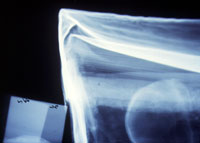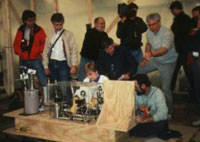Conservation Starts in the Field

Gammagram through lead coffin showing location and condition of skull. This was crucial planning information before researchers could raise and open the coffins.
After a project plan is established, the conservator may assist archaeologists in the field in several ways. They will strategize ways to recover fragile or deteriorated artifacts from the ground, and plan packing and transportation to the laboratory. Coordination between specialists is necessary for preparing samples and artifacts for analysis, conservation treatment, and further scientific study.
Prior to sampling the atmospheric gasses in the coffins, nuclear physicists conducted gamma ray imaging that showed the location of the human remains so that the sampling of atmospheric gasses would not damage anything. Following the air sampling, chilled argon gas was pumped into each coffin to delay decay through oxygen exposure. A team from NASA performed a final inspection by measuring the lead’s thickness and stability using electrical conductivity, infrared diffusivity, and ultrasonic probes. These measurements allowed the scientists to estimate the weights of each coffin.

Extracting atmospheric gasses from inside the largest coffin.
A specialized lifting apparatus was operated by a team from the Patuxent Naval Air Station to remove the coffins from the ground and transport them to a nearby field laboratory with minimal damage. Photographers documented the entire process.
 |
 |
 |


